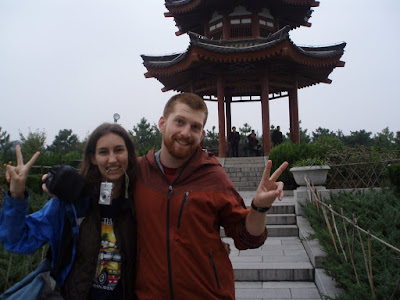On the first day of our vacation, we headed to the Muslim district of Xi'an, located in the center of the city, just near the Drum Tower. After winding through streets lined with vendors selling all kinds of Chinese souvenirs (I picked up a Mao lighter for a reasonable price), we made our way to the Great Mosque (大清真寺
Da Qingzhensi). Here's some information courtesy of Archnet.com:
"The Great Mosque of Xian is the largest and best preserved of the early mosques of China. Built primarily in the Ming Dynasty when Chinese architectural elements were synthesized into mosque architecture, the mosque resembles a fifteenth century Buddhist temple with its single axis lined with courtyards and pavilions.
The Great Mosque of Xian is thought to have existed as early as the seventh century. The mosque that stands today, however, was begun in 1392 in the twenty-fifth year of the Ming Dynasty. It was ostensibly founded by naval admiral and hajji Cheng Ho, the son of a prestigious Muslim family and famous for clearing the China Sea of pirates. Since the fourteenth century, the mosque has undergone numerous reconstructions. Most of the buildings existing today are from the Ming and Qing Dynasties of the seventeenth and eighteenth centuries. The mosque was constructed on Hua Jue Lane just outside the city walls built by the Ming Dynasty, in what was once the jiao-fang neighborhood for foreigners to the northwest of the city. Today, this neighborhood is part of Xian proper, with the city's famous Drum Tower a block away.
The mosque occupies a narrow lot about 48 meters by 248 meters, and the precinct walls enclose a total area of 12,000 square meters. Unlike many Chinese mosques, it has the layout of a Chinese temple: successive courtyards on a single axis with pavilions and pagodas adapted to suit Islamic function. Unlike a typical Buddhist temple, however, the grand axis of the Great Mosque of Xian is aligned from east to west, facing Mecca. Five successive courtyards, each with a signature pavilion, screen, or freestanding gateway, lead to the prayer hall located at the western end of the axis. "


The mosque provided an interesting mix of Chinese architecture and Muslim functionality.

The only worshipers in the mosque were men who wandered around the grounds wearing white linen caps.

Here we are situated in front of the prayer hall at the west end of the mosque (facing Mecca). We were lucky enough to arrive right before the Muslim prayer time (Salaah) began. There was a microphone in the hall so that worshipers could hear the prayer instructions, but whoever was nearest kept on coughing and burping, which was broadcast for the whole mosque to hear. It didn't quite facilitate a spiritually transcendent atmosphere.
 In this picture, probably a hundred people are crowded around a glass case containing something (I didn't bother to squeeze through the crowd to find out what). Most of these people couldn't even see it, but they were holding their cameras above their heads just to get a picture of whatever is inside.
In this picture, probably a hundred people are crowded around a glass case containing something (I didn't bother to squeeze through the crowd to find out what). Most of these people couldn't even see it, but they were holding their cameras above their heads just to get a picture of whatever is inside. Finally, we arrived at the main pit of the site, where the majority of the army is located. The sight of all these figures was extraordinary, although it required a lot more crowd-maneuvering just to get a clear view.
Finally, we arrived at the main pit of the site, where the majority of the army is located. The sight of all these figures was extraordinary, although it required a lot more crowd-maneuvering just to get a clear view. Here are some more warriors from close up. The really amazing thing about these figures is that fact that each one has different facial characteristics, which has led to the belief that they were modeled after the emperor's actual army.
Here are some more warriors from close up. The really amazing thing about these figures is that fact that each one has different facial characteristics, which has led to the belief that they were modeled after the emperor's actual army.












 A student recently told me that the Big Wild Goose Pagoda is the same building that is pictured on Chinese take-out cartons.
A student recently told me that the Big Wild Goose Pagoda is the same building that is pictured on Chinese take-out cartons.









